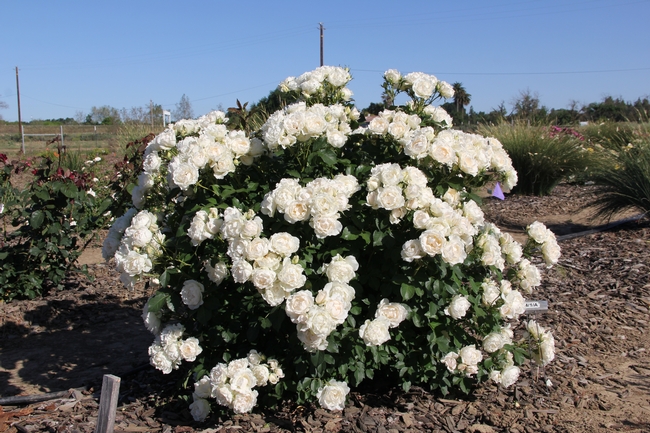Roses!
The word "rose" conjures up different images and feelings for different people. As landscape features they have long had a reputation for being garden princesses that require ample water, careful fertilization, and fungicide and insecticide treatment. Additionally, most people think they need to be pruned in very specific ways ("prune to a leaf of 5 leaflets"). But roses come in a large number of classes and species, and hybridization over the years has produced some really remarkably sturdy roses with none of these requirements to bloom and look great over a long season.
In the UC Landscape Plant Irrigation Trials (https://www.facebook.com/UCLPIT/), we have evaluated the water use and performance of 17 different landscape roses in hot, dry Davis. We have discovered that most of them perform beautifully on the low end of moderate water use, or about half of what a cool-season turfgrass, like tall fescue, needs. In our trials, the plants receive no fertilizer, no pesticides of any kind, and no special pruning techniques. During the late winter, we simply chop them down to about knee level! We actually learned this method from the director of the International Rose Test Garden in Portland, Oregon. The low-growing carpet roses get a cut back with electric hedge trimmers.
The secret to their performance on this irrigation level is the establishment year. We plant from bareroot stock in late winter, and water them through the first summer on regular, deep irrigation with a ring of drip irrigation tubing in the root zone of each plant- about once a week to a depth of 18 inches. We also use 2-3 inches of chipped wood mulch. The second summer they are good to go on only monthly irrigation with 14 gallons of water per plant, or about 3". If you are working with sandy soil, you would need to irrigate more frequently with less water.
New Rose Trial
Beginning in 2018, we will be evaluating new rose introductions as part of the American Rose Trials for Sustainability. These trials will be located in Stockton at the Robert J. Cabral Agricultural Center, and will trial 20 new cultivars each year. Unused turf areas will be converted this next week to rose trial grounds, and I will post pictures of the conversion as it progresses. One of the selling features of converting the ornamental, but useless turf sections was the calculated water savings: 3,656 ft2 of turf at 65% distribution uniformity would use 103,000 gallons of water, while 60 roses in the same area on drip will use 6,175 gallons, a 94% savings! Even though this is a trial layout, and not a densely planted landscape, that's still a great selling feature for converting this area to trials.
We look forward to finding more great landscape roses for sustainable California gardens.
Attached Images:
